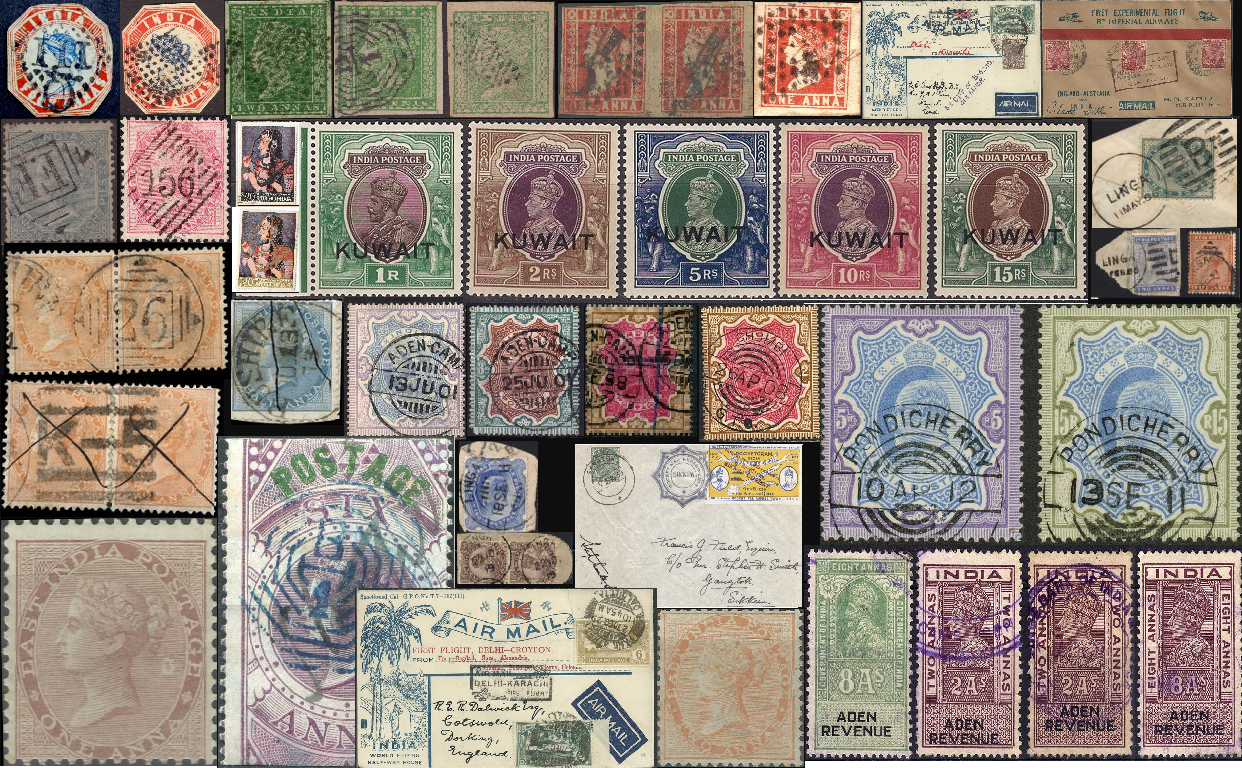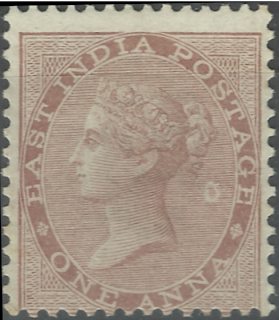Classic Indian Stamps of Queen Victoria-QV, King Edward-KEVII, King George-KGVI, Service, Mount Everest Expedition, Air-Railway Mails, RED Stamps, Numerical Cancel, Empire Collection Sterling Silver, FFC First Flight Covers, Army Post Office, Used Abroad.
The idea of creating this blog is to know & study more about the stamps that I have in my collection. Will also be able to know about the list of missing stamps that I need to get into my collection and to make a Virtual Stamp Album of my Stamp Collection.
I have organized my stamps with printed year and hope it will help exclusively for educational purposes.
Hope to promote and encourage the study, understanding, preservation and appreciation of the philately and postal history of India.
All Stamps Images
in this blog are from my collection.
1, One of the Rare QV Freak Flaw that was spotted by me .
I was scanning stamps for putting in the blog & I just found this unusual QV stamp that looked to me as a printing error behind the head.
You may find the discussion on this QV faw in the Stamp Forum below.
http://www.stampboards.com/viewtopic.php?f=10&t=50557
I had also discuses with SCOTT & SG and their view are below
What SCOTT had to say about this flaw :
The flaw on your stamp is not an error. It is a printing freak caused by a bit of foreign matter, such as a strand of thread, adhering to the printing plate. Populations of such freaks depend on how long the foreign matter interrupted printing before falling off, or being cleaned off by an observant pressman.
What SG had to say about this flaw:
There are two possible causes for this flaw:
1. It is the result of damage to the printing plate, possibly caused by something being dropped on it. If this were the case it would occur on one stamp in every sheet until the plate was replaced or repaired.
2. It is caused be some 'foreign matter', such as a hair being on the plate during printing. The hair prevents the ink getting to the paper, but subsequently falls off, leaving a small unprinted area. This probably occurred on just this one stamp.
Now, although option 1 would be the more common stamp, it would be much better than option 2, as collectors like to seek out constant flaws and ascertain their position on the sheet.
Until and unless further examples are discovered it is probably not possible to know whether your stamp is option 1 or option 2, but my guess is that it is the latter - an interesting 'freak' flaw.
I would be very interested to hear if anyone turns up a second example, however, suggesting that it is a constant flaw, which might be considered for listing if we can ascertain its sheet position.
#So I can tell you that this QV freak/flaw stamp from East India is one of it's Kind as of today.
2, RARE King Edward Flaw unearthed by me.
I was again scanning stamps for adding in this blog & then I just observed this printing variance on this King Edward VII stamp that looked to me as a printing error on the eye brow that is arched curve.
2, RARE King Edward Flaw unearthed by me.
I was again scanning stamps for adding in this blog & then I just observed this printing variance on this King Edward VII stamp that looked to me as a printing error on the eye brow that is arched curve.
About The Classic Indian Stamps:
The famous embossed "Scinde Dawk" stamps were the first Indian stamps that began issue on 1 July 1852 in the Scinde , for use in the Sind District.
These new stamps were embossed individually onto paper or a wax wafer. The shape was circular, with "SCINDE DISTRICT DAWK" around the rim and the British East India Company's Merchant's Mark as the central emblem. The paper was either white or greyish white. The blue stamp was printed onto the paper by the die during the embossing, while the wax version was embossed on a red sealing wax wafer on paper; but all had the same value of 1/2 anna. They were used until October 1854, and then officially suppressed.
The most interesting and popular area of Indian philately are the Indian Feudatory States, a challenging but rewarding area for study!
Below is a list of the Convention and Feudatory states in British India.
The Conventional States of British India
Chamba
Gwalior
Nabha
Patiala
Faridkot (formerly feudatory;convention from 1887)
Jind (formerly feudatory;convention from 1885)
Gwalior
Nabha
Patiala
Faridkot (formerly feudatory;convention from 1887)
Jind (formerly feudatory;convention from 1885)
The Feudatory States of British India
| Feudatory states (starting - ending years) | ||||
| Alwar (1877-1899) | Faridkot (1879-1900) | Morvi (1931-1935) | ||
| Bamra (1888-1893) | Hyderabad (1869-1949) | Nandgaon (1892-1893) | ||
| Barwani (1921-1938) | Idar (1939-1944) | Nowanuggur (1877-1893) | ||
| Bhopal (1876-1932) | Indore (1886-1941) | Orchha (1913-1939) | ||
| Bhor (1879-1901) | Jaipur (1900-1947) | Poonch (1876-1884) | ||
| Bijawar (1935-1937) | Jammu and Kashmir (1878-1886) | Rajasthan (1949-1949) | ||
| Bundi (1894-1941) | Jammu (1866-1877) | Rajpipla (1880) | ||
| Bussahir (1895-1900) | Jind (1874-1885) | Sirmur (1879-1899) | ||
| Bahawalpur (1947-1949) | Kashmir (1866-1867) | Soruth (1864-1937) | ||
| Charkhari (1894-1943) | Jasdan (1942-1942) | Travancore (1888-1946) | ||
| Cochin (1892-1933) | Jhalawar (1887-1887) | Travancore-Cochin (1949-1950) | ||
| Dhar (1897-1898) | Kishangarh (1899-1928) | Wadhwan (1888-1889) | ||
| Duttia (1893-1916) | Las Bela (1897-1904) | |||
The Classic Indian Stamps that where used abroad
For postmark hunters, Indian Stamps where used abroad in the Aden ,Abadan, Ahwaz, Bandar-abas, Guadur, Pasni, Henjam, Dozdab Indian Exchange P.O., Koh-I-Mauk-Siah-Ziarat, Zanzibar, Somaliland, Sudan, Abyssinia /Abyssinian field forces, Mombassa, , Busrah , Burma, Bandar Abbas, Linga , Mahommera, Batavia, Afghanistan , Iran , Bushire , Iraq, Bagdad ,Malaya, Malacca Penang, Straits Settlements, including Singapore, Cochin, scarce Tibet including Lahssa, Gangtok, Pharijon, Gyantse ,Yatung Nepal, Everest Expedition, Zanzibar and other areas are a fascinating area to collect.
Many of the Victorian to KGVI stamps were overprinted for use in the Convention States, as well as for use abroad such as Arabian Gulf , Persian Field Force, Bahrain, Dubai, Kuwait , Muscat, and from Pondicherry and Karikal of French India.
East Africa, Tranquebar Danish settlement and others, sub-offices including Maalla, Kamaran, Dthali, Perim, Khormaksar, Sheikh and Othman .
Many of the Victorian to KGVI stamps were overprinted for use in the Convention States, as well as for use abroad such as Arabian Gulf , Persian Field Force, Bahrain, Dubai, Kuwait , Muscat, and from Pondicherry and Karikal of French India.
East Africa, Tranquebar Danish settlement and others, sub-offices including Maalla, Kamaran, Dthali, Perim, Khormaksar, Sheikh and Othman .
Modern Indian Stamps
All modern Indian Stamps are colorful and very attractive, and there are many rare missing colors and other varieties that can be found.
Will be publishing here soon the list of most valuable stamps from these modern period .
I am planning to add my classic INDIAN stamps that are in my collection weekly , just check the links !
Don't forget to leave your comments and feedback for Improvement !





Comments
Post a Comment